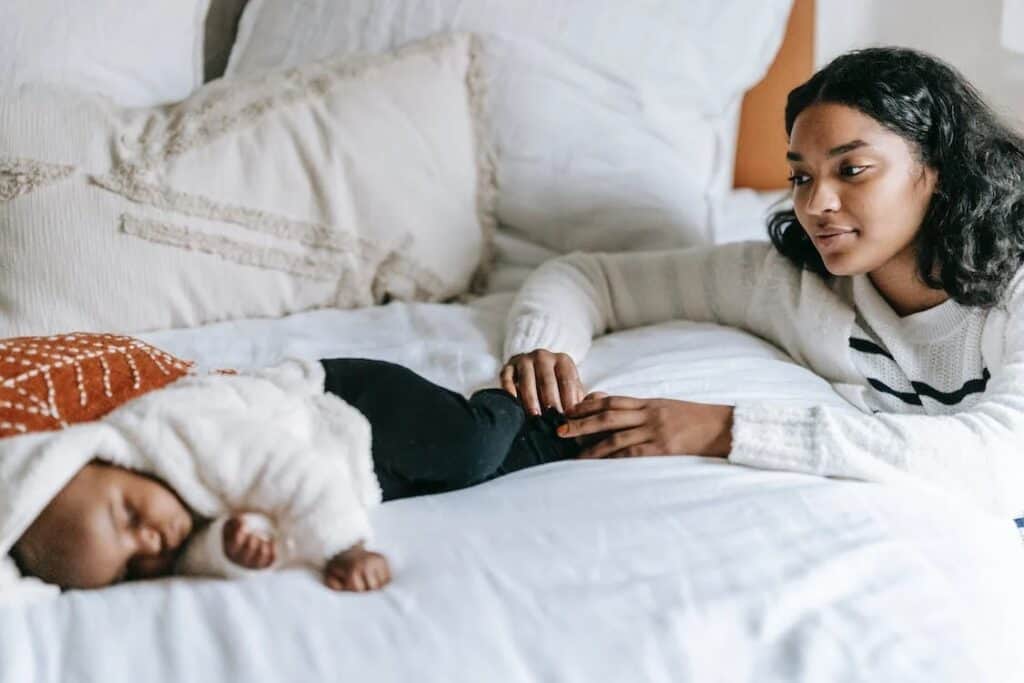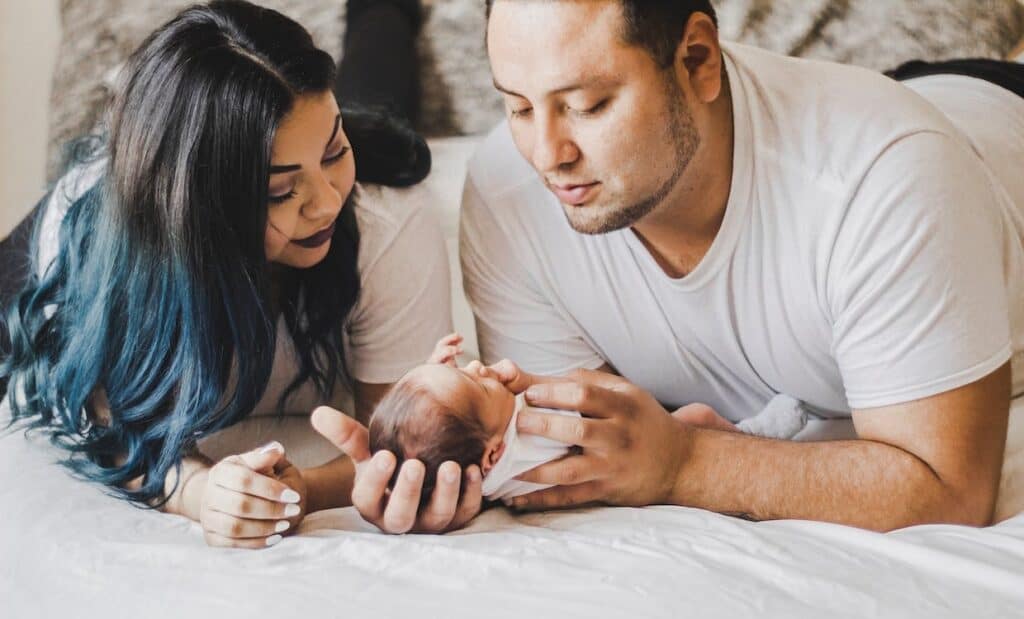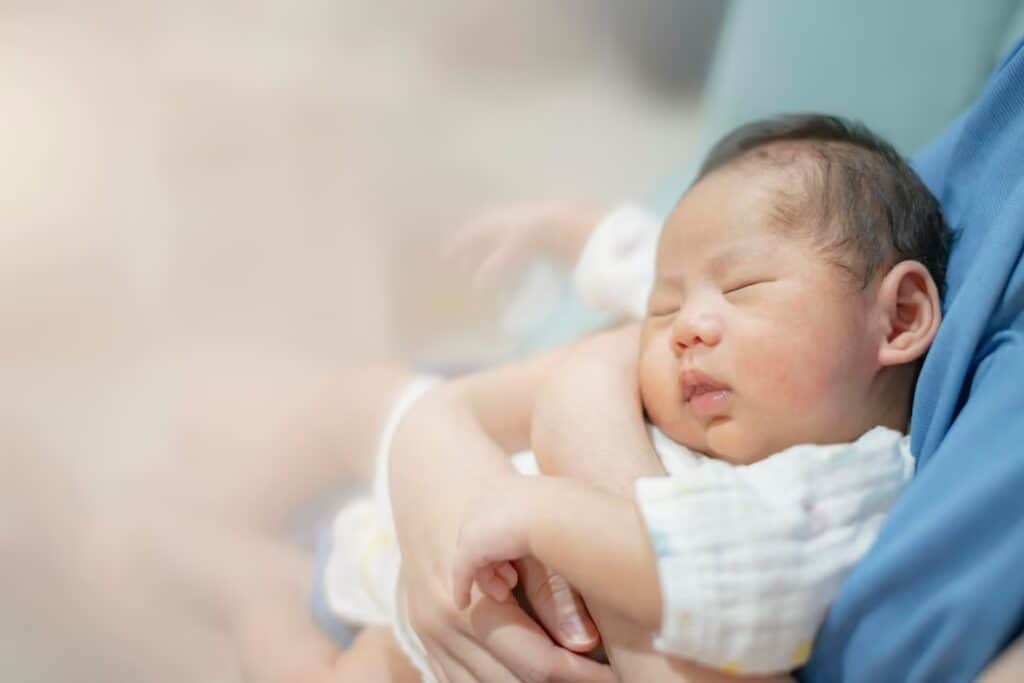Newborns are known for their unpredictable sleep patterns, leaving many new parents wondering what the best sleep arrangement is for their little one. One common question that arises is whether it is safe for a newborn to sleep on their parent’s chest. While it may seem like a cozy and comforting option, it is important to understand the potential risks and benefits of this sleeping arrangement.
Understanding newborn sleep is crucial when considering the safety of chest sleeping. Newborns require a lot of sleep, typically around 14-17 hours per day, but their sleep is often fragmented and unpredictable. It is important for parents to create a safe and comfortable sleep environment for their baby to ensure they are getting the rest they need. Safe sleep guidelines for newborns recommend placing them on their back to sleep on a firm and flat surface, free from any loose bedding or soft objects that could pose a suffocation risk.
Key Takeaways
- Newborns require a lot of sleep, but their sleep is often unpredictable and fragmented.
- Safe sleep guidelines recommend placing newborns on their back to sleep on a firm and flat surface.
- While chest sleeping may seem like a cozy option, it is important to understand the potential risks and benefits before making a decision.
Understanding Newborn Sleep
Newborn Sleep Patterns
Newborns have a unique sleep pattern that is different from adults and older children. They sleep for shorter periods of time, usually between 16-17 hours a day, and wake up frequently for feeding and diaper changes. The sleep cycle of a newborn is also different from adults, with more time spent in REM (Rapid Eye Movement) sleep, which is important for brain development.

It is important to note that newborns do not have a set sleep pattern and may sleep for different durations at different times of the day and night. They may also have trouble falling asleep on their own and need to be soothed or rocked to sleep.
Sleep Schedule for Newborns
Newborns do not have a set sleep schedule and may sleep for short periods throughout the day and night. It is important to establish a routine for sleep and wake times to help regulate their sleep pattern.
Here are some tips for establishing a sleep schedule for newborns:
- Encourage daytime naps: Newborns need to sleep for shorter periods throughout the day. Encourage them to nap during the day by keeping the room quiet and dark.
- Establish a bedtime routine: Establish a consistent bedtime routine that includes soothing activities such as a warm bath, reading a story, or singing a lullaby.
- Follow a consistent sleep schedule: Try to put the baby to sleep and wake them up at the same time every day. This will help regulate their sleep pattern and make it easier for them to fall asleep on their own.
In conclusion, understanding newborn sleep patterns and establishing a sleep schedule can help parents ensure that their baby gets enough rest. It is important to be patient and consistent when establishing a sleep routine for newborns.
Safe Sleep Guidelines for Newborns
The Back is Best
The American Academy of Pediatrics recommends that newborns should always be placed on their backs to sleep. This is the safest position for a baby to sleep and reduces the risk of Sudden Infant Death Syndrome (SIDS). It is important to place your baby on their back every time they sleep, including for naps. Once your baby can roll over on their own, you do not need to worry about repositioning them during sleep.
Choosing the Right Sleep Environment
In addition to placing your baby on their back to sleep, it is important to create a safe sleep environment. Your baby should always sleep on a firm surface, such as a crib or bassinet. Soft surfaces, such as adult beds, couches, or chairs, can increase the risk of suffocation or SIDS.
When selecting a crib or bassinet, make sure it meets current safety standards. The space between the slats should be no more than 2 3/8 inches apart, and the mattress should fit snugly in the crib or bassinet. Avoid using any loose bedding, such as blankets or pillows, in the crib or bassinet.

Swaddling can be a helpful technique to soothe a newborn, but it is important to do it safely. Use a swaddle that is specifically designed for newborns and do not swaddle too tightly. Make sure your baby’s hips can move freely and that the swaddle does not cover their face.
Finally, it is important to keep your baby’s sleeping area free of any hazards. This includes keeping toys, blankets, and other objects out of the crib or bassinet, and keeping the sleeping area away from cords or other potential hazards.
Remember, following safe sleep guidelines can help reduce the risk of SIDS and other sleep-related accidents. If you have any questions or concerns about safe sleep, talk to your pediatrician.
The Pros and Cons of Co-sleeping
The Benefits of Co-sleeping
Co-sleeping, or sleeping with a newborn on one’s chest, can have several benefits for both the baby and the parent. One of the most significant advantages is the comfort and bonding that it provides. Sleeping on the chest of a parent can help the baby feel secure and safe, which can lead to better sleep. Additionally, skin-to-skin contact can help regulate the baby’s temperature, breathing, and heart rate, leading to improved health outcomes.

Co-sleeping can also make it easier for new parents to care for their baby, particularly if they are breastfeeding. Being in close proximity to the baby can make it easier to feed and soothe them during the night, which can help both the baby and parent get more restful sleep. Additionally, co-sleeping can help new parents feel more connected to their baby, which can be particularly important during the first few weeks and months of parenthood.
The Risks of Co-sleeping
While there are several benefits to co-sleeping, there are also some risks that parents should be aware of. One of the most significant risks is the potential for suffocation. Pillows, blankets, and other bedding can pose a suffocation risk if they cover the baby’s face or obstruct their breathing. Additionally, if a parent falls asleep while holding their baby, there is a risk that the baby could fall or be accidentally smothered.
Another risk of co-sleeping is the potential for the baby to become accustomed to sleeping on a parent’s chest. This can make it difficult for the baby to transition to sleeping in a crib or bassinet, which can be a problem as they get older. Finally, bed-sharing can also pose a risk if the parent is not a light sleeper or if they have been drinking or taking medication that could impair their ability to wake up if the baby is in distress.
Overall, co-sleeping can be a safe and effective way to help newborns sleep better and bond with their parents. However, it is important for parents to be aware of the risks and take steps to minimize them, such as using a firm mattress, avoiding pillows and blankets, and ensuring that the baby is always placed on their back to sleep. Additionally, parents should never fall asleep while holding their baby and should always ensure that they are in a safe sleeping environment.
Sleeping on the Chest: Is It Safe?
Newborns often feel most secure when they are held close to their caregiver’s chest. This is because it provides them with skin-to-skin contact, warmth, and comfort. However, parents may wonder if it is safe for a newborn to sleep on their chest. Here’s what you need to know.
Potential Hazards
There are potential hazards associated with allowing a newborn to sleep on an adult’s chest. One of the biggest concerns is the risk of suffocation. When an adult is sleeping, they may not be aware of their movements, and the newborn could become trapped under their body or in a position that obstructs their airway.
Another concern is the risk of strangulation. If a newborn is sleeping on an adult’s chest and the adult rolls over, the newborn could become trapped between the adult’s body and the bed or couch. This can be extremely dangerous and could lead to serious injury or death.
When Is It Okay?
It is generally not recommended for newborns to sleep on an adult’s chest, especially if the adult is sleeping. However, there are some situations where it may be okay for short periods of time, as long as certain precautions are taken.
For example, if a newborn is awake and being comforted by their caregiver, it may be okay for them to sleep on their chest for a short period of time. It is important to ensure that the newborn’s airway is clear and that they are not in a position that could obstruct their breathing.

Additionally, if a newborn is sleeping on an adult’s chest, the adult should remain awake and alert at all times. They should never fall asleep with the newborn on their chest, as this can be extremely dangerous.
In summary, while sleeping on an adult’s chest can provide newborns with comfort and security, it is generally not recommended due to the potential hazards. If a newborn must sleep on an adult’s chest, certain precautions should be taken to ensure their safety.
Alternatives to Chest Sleeping
While chest sleeping may be a tempting option for new parents, it is important to consider the potential risks involved. Fortunately, there are several safe alternatives to chest sleeping that can provide the same comfort and bonding experience for both parent and baby.
Swaddling Techniques
Swaddling is a time-tested technique that can help soothe and comfort newborns. By wrapping the baby snugly in a blanket, swaddling can help recreate the feeling of being in the womb, providing a sense of security and warmth. There are several swaddling techniques to choose from, including the traditional blanket swaddle, the sleep sack swaddle, and the double swaddle. It is important to ensure that the swaddle is not too tight, as this can restrict breathing and cause overheating.

Using a Bassinet
A bassinet is a safe and convenient option for newborn sleep. Placed next to the parents’ bed, a bassinet allows for easy access to the baby for feeding and comforting, while also providing a separate sleeping surface. When choosing a bassinet, it is important to ensure that it meets current safety standards and is placed on a flat, stable surface. It is also recommended to avoid using any loose bedding or soft objects in the bassinet, as these can pose a suffocation risk.
Overall, there are several safe and effective alternatives to chest sleeping that can provide comfort and security for both parent and baby. By using swaddling techniques and a bassinet, parents can ensure that their newborn is sleeping safely and soundly.
Conclusion
In summary, it is generally safe for a newborn to sleep on a parent’s chest as long as certain precautions are taken. The American Academy of Pediatrics recommends that infants sleep on their backs on a firm and flat surface, such as a crib or bassinet, to reduce the risk of sudden infant death syndrome (SIDS). However, if a parent chooses to hold their baby on their chest while they sleep, they should follow these guidelines:
- The parent should be awake and alert while holding the baby.
- The baby should not be placed on a soft surface, such as a couch or armchair, which could increase the risk of suffocation.
- The parent should not be under the influence of drugs or alcohol, which could impair their ability to respond to the baby’s needs.
- The baby should not be swaddled while sleeping on the parent’s chest, as this could increase the risk of overheating and suffocation.
It is important to note that while sleeping on a parent’s chest may be comforting for both the baby and the parent, it is not a substitute for safe sleep practices. Infants should always be placed on their backs to sleep on a firm and flat surface, free from any soft objects or loose bedding.
Overall, while it may be tempting to let a newborn sleep on a parent’s chest, it is important to prioritize safety and follow the guidelines set forth by pediatric experts. As with all aspects of parenting, it is important to stay informed and make informed decisions that prioritize the health and well-being of the baby.
Related Posts:
Frequently Asked Questions
Is it safe for a newborn to sleep on their parent’s chest?
Yes, it is generally safe for a newborn to sleep on their parent’s chest if certain precautions are taken. The parent should be awake and alert, and the baby should be placed on their back with their airway clear and unobstructed. It is important to note that this sleeping arrangement should only be temporary and not a long-term solution.
Can sleeping on the chest increase the risk of SIDS?
There is no evidence to suggest that sleeping on a parent’s chest increases the risk of SIDS. However, it is important to follow safe sleep guidelines to reduce the risk of SIDS, including placing the baby on their back to sleep, using a firm and flat sleep surface, and keeping soft objects and loose bedding out of the sleep area.
What are the dangers of falling asleep with a baby on your chest?
Falling asleep with a baby on your chest can increase the risk of accidental suffocation or SIDS. It is important to stay awake and alert while holding a sleeping baby, and to place the baby in a safe sleep environment as soon as possible.
Can a newborn sleep on their tummy on their parent’s chest?
No, it is not safe for a newborn to sleep on their tummy on their parent’s chest. This position can increase the risk of suffocation and SIDS. The baby should always be placed on their back to sleep, on a firm and flat surface.
How long can a newborn safely sleep on their parent’s chest?
A newborn should not sleep on their parent’s chest for an extended period of time. The American Academy of Pediatrics recommends that infants sleep in the same room as their parents, but on a separate sleep surface, such as a crib or bassinet, for at least the first six months of life.
What are some tips for transitioning a newborn from sleeping on their parent’s chest to a crib?
To transition a newborn from sleeping on their parent’s chest to a crib, parents can start by placing the baby in the crib for short periods of time while they are awake and supervised. Gradually increase the amount of time the baby spends in the crib, and use soothing techniques to help the baby adjust to the new sleep environment. It is important to follow safe sleep guidelines and to avoid using soft objects or loose bedding in the crib.
